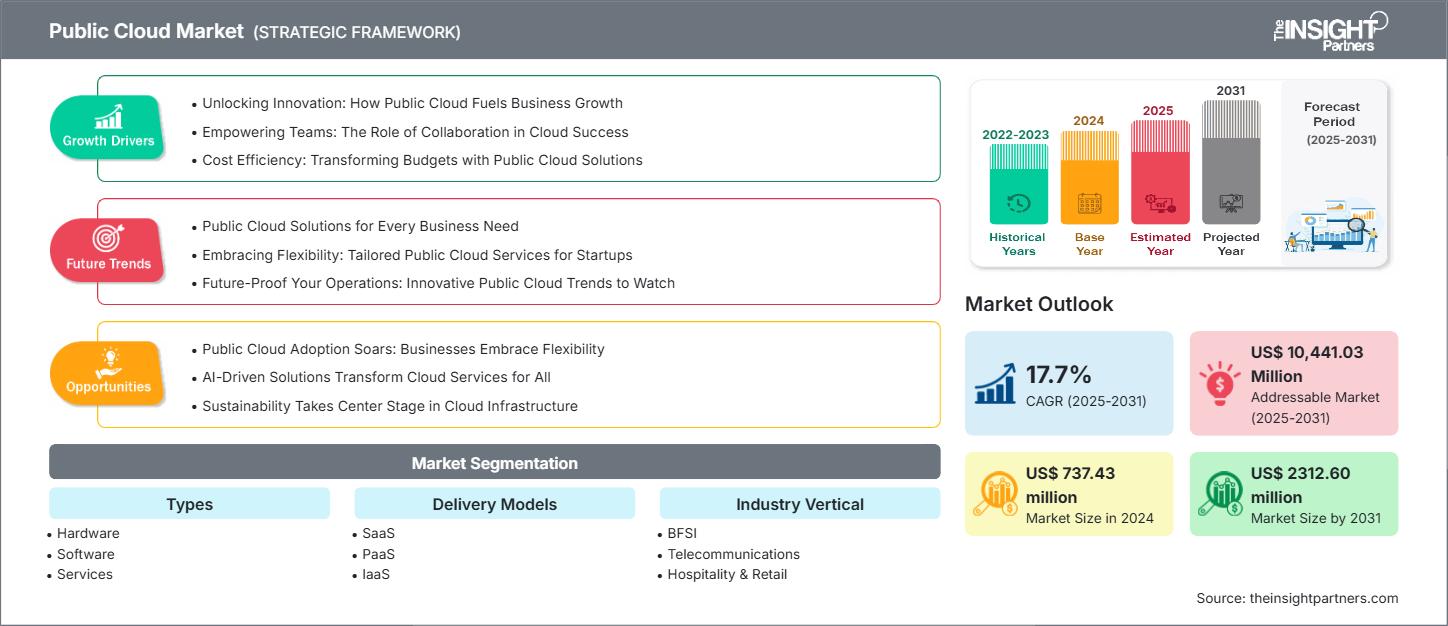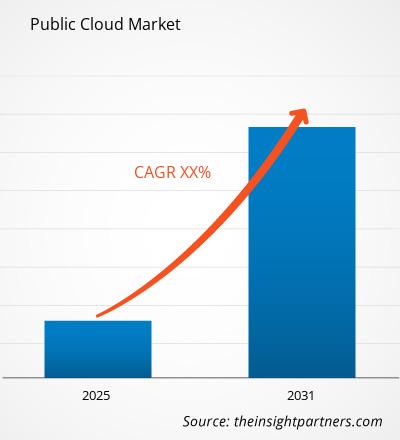Es wird erwartet, dass der Markt für öffentliche Cloud-Dienste bis 2031 ein Volumen von 684,47 Milliarden US-Dollar erreichen wird. Für den Zeitraum 2025–2031 wird ein durchschnittliches jährliches Wachstum von 14,8 % prognostiziert.
Cloud-Dienste fungieren als Speicheranbieter oder Drittanbieter, bei denen die Daten von Organisationen für verschiedene Zwecke gespeichert werden. Die gespeicherten Daten werden anschließend für Analysezwecke abgerufen. Der Begriff „Public Cloud“ bezeichnet Cloud-Dienste, die über ein öffentliches Netzwerk angeboten und remote zugänglich sind. Der größte Vorteil des Public-Cloud-Modells besteht darin, dass Organisationen sich weniger um die Speicherung und Wartung ihrer Daten kümmern müssen. Die Einrichtung erfolgt extern, und die Architektur ist mandantenfähig, sodass mehrere Organisationen die Rechenkapazität des Drittanbieters gemeinsam nutzen. KMU profitieren besonders, da sie die Speicherung und Wartung ihrer Daten an Cloud-Anbieter auslagern und dadurch erhebliche Investitionen in den Infrastrukturaufbau einsparen. Kosteneinsparungen, schnellere Entwicklung, Testphase und kürzere Markteinführungszeiten haben viele Unternehmen verschiedenster Branchen dazu bewogen, die Public-Cloud-Technologie einzuführen.
Sie erhalten eine kostenlose Anpassung aller Berichte – einschließlich Teilen dieses Berichts, Länderanalysen und Excel-Datenpaketen – sowie attraktive Angebote und Rabatte für Start-ups und Universitäten.
Public-Cloud-Markt: Strategische Einblicke

- Ermitteln Sie die wichtigsten Markttrends dieses Berichts.Diese KOSTENLOSE Probe beinhaltet eine Datenanalyse, die von Markttrends bis hin zu Schätzungen und Prognosen reicht.
In den letzten zehn Jahren hat die Softwarebranche massive Veränderungen erlebt. Die Einführung von Cloud-Modellen durch Unternehmen war dabei aufgrund der damit verbundenen Vorteile wegweisend. Die hohe Skalierbarkeit von Geschäftsprozessen veranlasst Unternehmen, sich für Cloud-basierte Dienste zu entscheiden, da die Daten in den Speicherzentren je nach Bedarf flexibel skaliert werden können. Darüber hinaus basiert das Preismodell der Public-Cloud-Anbieter in der Regel auf nutzungsbasierter Abrechnung. Unternehmen, insbesondere KMU, müssen keine hohen Summen auf einmal bezahlen, was die Nutzung der Public Cloud für ihre Geschäftsprozesse besonders attraktiv macht. Die Kernkompetenzen der Unternehmen bleiben erhalten, wodurch sie in diesem dynamischen Markt wettbewerbsfähig bleiben. Reduzierte Betriebskosten und die Vielzahl an branchenspezifischen Lösungen aus einer Hand sind die Haupttreiber für den Markt für Public-Cloud-Dienste. Auch der Bedarf an einer skalierbaren, flexiblen, einfachen und effizienten IT-Infrastruktur treibt diesen Markt maßgeblich an. Menschliche Fehler werden minimiert, da die Prozesse vollständig maschinell gesteuert werden, was Unternehmen letztendlich dazu bewegt, Public-Cloud-Dienste zu nutzen. Die genannten Faktoren erklären die exponentielle Verbreitung dieses Marktes. Trotz der weitverbreiteten Nutzung in den Industrieländern stößt das Wachstum von Public-Cloud-Diensten auf einige Einschränkungen. Sicherheitsbedenken hinsichtlich des Datenschutzes stellen den größten Hemmfaktor dar. Die Anforderungen an die Internetverbindung sind hoch, was die Implementierung in Ländern mit schlechter Anbindung beeinträchtigt. Auch die Integration des Modells in bestehende Systeme wirkt sich hemmend aus. Weitere Einschränkungen sind Ausfälle und die Datenmobilität.
Regionale Einblicke in den Markt für öffentliche Cloud-Dienste
Die regionalen Trends und Einflussfaktoren auf den Public-Cloud-Markt im gesamten Prognosezeitraum wurden von den Analysten von The Insight Partners ausführlich erläutert. Dieser Abschnitt behandelt außerdem die Marktsegmente und die geografische Verteilung des Public-Cloud-Marktes in Nordamerika, Europa, Asien-Pazifik, dem Nahen Osten und Afrika sowie Süd- und Mittelamerika.
Berichtsumfang zum Markt für öffentliche Cloud-Dienste
| Berichtattribute | Details |
|---|---|
| Marktgröße im Jahr 2024 | US$ XX Milliarden |
| Marktgröße bis 2031 | 684,47 Milliarden US-Dollar |
| Globale durchschnittliche jährliche Wachstumsrate (2025 - 2031)CAGR (2025 - 2031) | 14,8 % |
| Historische Daten | 2021-2023 |
| Prognosezeitraum | 2025–2031 |
| Abgedeckte Segmente | Nach Typen
|
| Abgedeckte Regionen und Länder | Nordamerika
|
| Marktführer und wichtige Unternehmensprofile |
|
Marktdichte der Public-Cloud-Anbieter: Auswirkungen auf die Geschäftsdynamik verstehen
Der Markt für Public-Cloud-Dienste wächst rasant, angetrieben durch die steigende Nachfrage der Endnutzer. Gründe hierfür sind unter anderem sich wandelnde Verbraucherpräferenzen, technologische Fortschritte und ein wachsendes Bewusstsein für die Vorteile des Produkts. Mit steigender Nachfrage erweitern Unternehmen ihr Angebot, entwickeln innovative Lösungen, um den Kundenbedürfnissen gerecht zu werden, und nutzen neue Trends, was das Marktwachstum zusätzlich beflügelt.

- Verschaffen Sie sich einen Überblick über die wichtigsten Akteure im Public-Cloud-Markt.
Der globale Markt für öffentliche Cloud-Dienste ist nach Typen in Hardware, Software und Services unterteilt. Darüber hinaus erfolgt eine weitere Segmentierung nach Bereitstellungsmodell in SaaS, PaaS und IaaS. Zusätzlich wird der Markt nach Endnutzern segmentiert, nämlich in KMU und Großunternehmen. Die Marktsegmentierung erfolgt auch nach Branchen, darunter Banken, Finanzdienstleistungen und Versicherungen (BFSI), Telekommunikation, Gastgewerbe und Einzelhandel, öffentliche Verwaltung, Fertigung und Gesundheitswesen. Nordamerika ist aufgrund bemerkenswerter technologischer Fortschritte und der sozioökonomischen Entwicklung der Region führend auf dem globalen Markt für öffentliche Cloud-Dienste. Europa, ein weiteres wichtiges Industriezentrum, trägt zum Wachstum des Marktes für öffentliche Cloud-Dienste bei. Die nordischen Länder Europas mit ihren vielen kleinen Unternehmen haben maßgeblich zum europäischen Marktanteil beigetragen. Auch die APAC-Region holt stetig auf, wobei Entwicklungsländer wie Indien und China zunehmend in Technologien für öffentliche Cloud-Dienste investieren. Zu den wichtigsten Akteuren auf dem globalen Markt für öffentliche Cloud-Dienste gehören unter anderem Microsoft Corporation, Salesforce.com, Cisco Systems, Inc., VMware, Google, Inc., Oracle Corporation und Eucalyptus.
- Historische Analyse (2 Jahre), Basisjahr, Prognose (7 Jahre) mit CAGR
- PEST- und SWOT-Analyse
- Marktgröße Wert/Volumen – Global, Regional, Land
- Branchen- und Wettbewerbslandschaft
- Excel-Datensatz
Aktuelle Berichte
Erfahrungsberichte
Grund zum Kauf
- Fundierte Entscheidungsfindung
- Marktdynamik verstehen
- Wettbewerbsanalyse
- Kundeneinblicke
- Marktprognosen
- Risikominimierung
- Strategische Planung
- Investitionsbegründung
- Identifizierung neuer Märkte
- Verbesserung von Marketingstrategien
- Steigerung der Betriebseffizienz
- Anpassung an regulatorische Trends






















 Kostenlose Probe anfordern für - Public Cloud-Markt
Kostenlose Probe anfordern für - Public Cloud-Markt